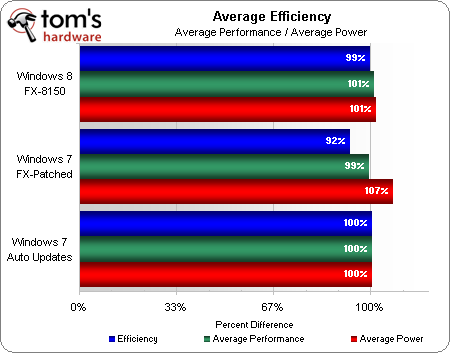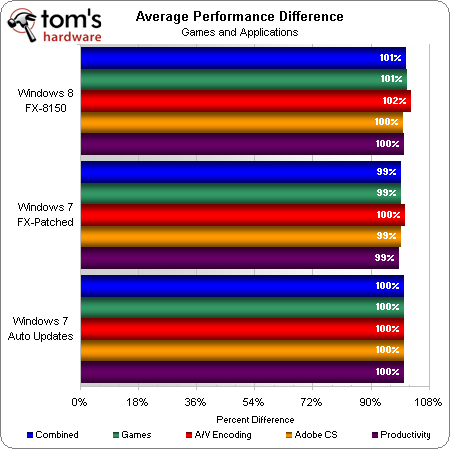Windows 8: Does AMD's Bulldozer Architecture Benefit?
Shortly after AMD's Bulldozer architecture launched, AMD had us anticipating a couple of hotfixes that were supposed to improve FX-8150's performance. But Windows 8 was the ultimate goal. Now that the operating system is out, does it help FX-8150?
Does Windows 8 Help Improve Bulldozer's Performance?
One of Microsoft's Windows 7 hotfixes alters the behavior of Core Parking, preventing AMD's Bulldozer modules from entering a C6 sleep state as often. Applying that patch has a quantifiable impact on power consumption, which, in turn, negatively affects the efficiency of FX-8150. In Windows 8, that efficiency conundrum is largely resolved, bringing power use back down to the level of Windows 7 with all automatic updates applied.
But how does the performance story shake out? After all, everyone who bought a Bulldozer-based CPU (and anyone now in the market for a Piledriver-based FX) is hoping for sizable gains.
Our testing shows that the FX-8150’s performance doesn't change much at all in the shift from Windows 7 to Windows 8.
The last time we looked at the impact of Microsoft's hotfixes was almost a year ago. In today's comparison, our baseline Windows 7 machine is loaded with a lot more patches from Windows Update, and they cumulatively seem to have a larger impact than the two manually-installed tweaks specific to AMD's Bulldozer architecture. In fact, overall performance is better without the hotfixes applied.
Installing Windows 8 does translate to slightly faster benchmark numbers, and without the power spike. But Microsoft's latest certainly cannot be expected to uncork results that many enthusiasts were hoping might have been bottled up by a poorly-optimized operating system. The onus for fixing Bulldozer was clearly on AMD, and we saw the company take a first step toward that goal with its Piledriver-based FX parts.
AMD told us not to expect any additional performance from FX-8350 prior to our review. But now that we know Microsoft plans to roll out performance- and power-altering updates to Windows 8 right away, rather than waiting for a service pack, there's renewed hope for even a small nudge forward.
Then again, software fixes for hardware problems are only viable when software was the problem originally. I remember once telling a programmer that his computer had a bad memory module. Rather than swapping it out, he charged in with determination to create a software-based solution. Had he identified the bad memory cells and kept his system from accessing them, he might have enjoyed about as much success as AMD waiting for Windows 8.
Get Tom's Hardware's best news and in-depth reviews, straight to your inbox.
I eventually talked the programmer into fixing the hardware problem, rather than doggedly looking for a never-quite-finished software solution. AMD, do you see where I’m going with this?
Current page: Does Windows 8 Help Improve Bulldozer's Performance?
Prev Page Benchmark Results: Productivity-
agnickolov Of particular interest to me is that compilation with Visual Studio does slow down a bit on Windows 8. Not what the story was about, but still a valuable tidbit...Reply -
Crashman boogien8LOL awesome! the last line of this review is epic!That last line is the result of AMD creating unrealistic expectations for Windows 8. Things have gotten somewhat better for AMD since Piledriver launched, it's too bad that this article was written before that launch :)Reply -
silverblue I wouldn't mind seeing if, with Windows 8 and the 8350, hardware can take full advantage of the software instead of the other way around. I was a little dubious about blaming Microsoft in the first place - this isn't quite the Vista scheduler and Phenom all over again.Reply
Good article. :) It does seem that the patches create more problems than they solve, so I'd be inclined to ignore them if I had an FX on Windows 7. -
esrever Nice to see this finally tested, looks like the performance boost isn't significant enough to matter but at least there is a 1% increase. AMD can use all the minor performance boost they can get at this point.Reply -
Belardo Throw in the Intel i5-3550 and 3570K CPUs with Win7 and Win8 and see what the numbers say... wouldn't that be fair to see the difference as well?Reply
DjEaZy... gonna get me a FX 8350 anyway... it's cheep as dirt and i have the platform... Yeah, if you already have the board and memory, its mostly logical. But for someone going for a rebuild... it is not, especially if you live near a Microcenter.
I paid $190 for my i5-3570K CPU, $90 for my Z77 gigabyte motherboard which out-does AMD 900 Series boards. Z77 have native USB 3.0, SATA 3.0, PCIe 3.0... AMD doesn't have PCIe 3.0 until 2014. And unless you get an A-Series CPU, you don't have native USB 3.0 either.
This, an AMD boards are a bit more costly and more complicated.
The OTHER AMD problem is that they are packaging clean CPU coolers with their CPUs... they are loud!! So add $25 for a good replacement. The extra costs for electricity doesn't help.
-
Reply
The Emperor's New Clothes9538570 said:Nice to see this finally tested, looks like the performance boost isn't significant enough to matter but at least there is a 1% increase. AMD can use all the minor performance boost they can get at this point.


